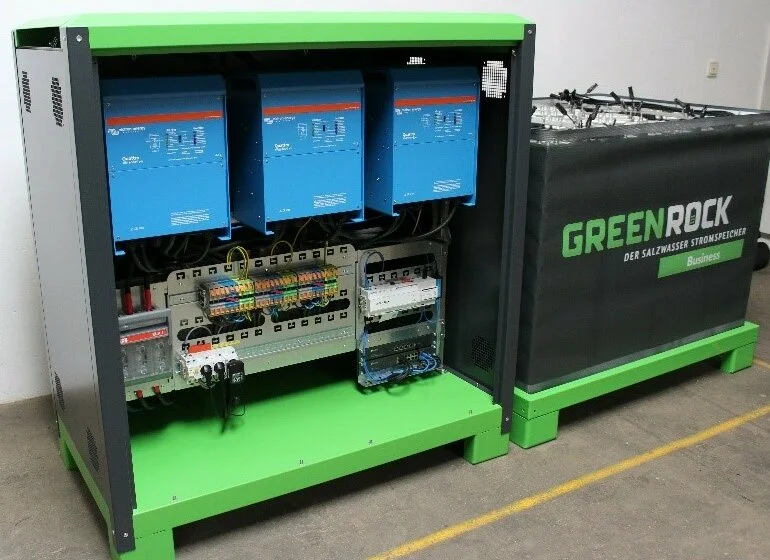Pasta is one thing you won’t be able to prepare using the contents of what are known as salt water batteries. For the aqueous solution doesn’t contain table salt, but rather special sodium-based salts. However, the solution does have a few notable things in common with pasta water. Both fluids are neither corrosive, nor caustic, giving way to numerous benefits versus electric batteries such as lithium-ion, lead or redox flow batteries.
Easy to use
Thanks to the harmless battery fluid, salt water batteries can be installed almost anywhere without the need to make any additional adjustments: “Our Greenrock systems do not require any special fire protection measures, they can be set up without separation trays for escaping liquid and are very easy to install thanks to the software supplied”, says Helmut Mayer, CEO of Austrian company Bluesky Energy, which sells these batteries. “They can also be transported as normal goods without hazard warnings.”
This is not only a safety bonus for homeowners. Suppliers consider their target market to be schools, hospitals and supermarkets that generate their own solar power, for example.
Application to date: stationary systems in continuous operation
The downside of the salt water batteries, which are currently available on the market, is their energy density. They need twice the space of lithium-ion batteries to provide the same amount of stored electricity. The reason for this is that aqueous electrolytes are only able to achieve a cell voltage that is around three times lower than that of lithium-ion batteries. Otherwise, water (H2O) breaks down into its components hydrogen and oxygen. Furthermore, the power – i.e. the amount of energy the battery can transfer at the same time – is only half that of conventional batteries with the same capacity.
A salt water battery with a capacity of ten kilowatt hours – a good size for solar systems mounted on single-family homes – can only provide two kilowatts of power. So if you want to wash your clothes at 60 degrees or use the oven in the evening, you will probably have to buy some extra electricity from the grid. These systems are not an alternative for mobile applications such as electric cars or even portable electronic devices either, says Helmut Mayer of Bluesky Energy: “But where weight, space and maximum power are of secondary importance, they are a sustainable alternative.” For example, large salt water storage tanks can be used to cover the fairly constant power requirements of servers and security systems.
Advantages in certain areas of application
Salt water batteries are by no means a new concept. The first models were developed around the same time as lithium-ion technology, but they are nowhere near as common today. However, they can certainly compete with traditional batteries in terms of price – calculated over their lifetime.
The German Association for Energy Storage BVES sees potential. “Salt water batteries are a technical concept which very much harbours certain advantages in certain areas of application, earning itself a valid place within the power storage industry,” is the answer given when inquired by en:former. So far, however, the products have barely been able to establish themselves on the market. This is partly due to the fact that all areas of Li-ion technology, from production processes right down to cell chemistry, are evolving rapidly, driven by electromobility – both from a technical perspective and in terms of costs.
Future potential as a large-scale storage solution
In Switzerland, a research team is working to further develop the technology: “We have found special salts which we have used to double the maximum possible voltage and energy density of the cell,” explains David Reber from the Swiss Federal Laboratories for Materials Testing and Research (EMPA). “And this new approach doesn’t compromise the increased safety of aqueous electrolytes.” An added bonus is that the already considerable service life of salt water batteries has also been further increased.
Under laboratory conditions these batteries are almost equal to current battery storage systems, says Reber. Theoretically, it could even be conceivable that salt water batteries one day replace their lithium-ion counterparts in electric cars or mobile phones. However, that is not the primary goal of the EMPA researchers: “We see this technology finding its home in large-scale storage facilities,” explains Reber, “where the increased safety and lower costs compensate for the shortcomings in terms of energy density.”
However, Reber explains that there is still much to be done before the product is ready for the market: “It will certainly take another three years before we are able to provide a product that can replace lead batteries in stationary storage units, for example.”
Photo credit: Sthaporn Kamlanghan, shutterstock.com

